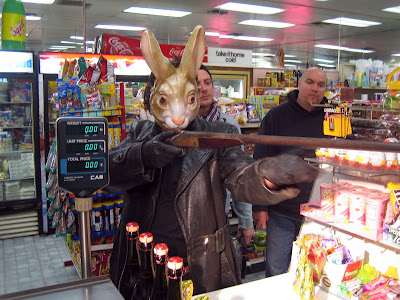 |
| Grasshopper: Shot on Digital |
Recently, a dear friend of mine was updating their website. They asked me to shoot some new photos for the site. My friend is an artistic person, and wanted the photos in Black and White. This seemed like a no brainer. I love shooting Black and White Film. I process and print my own negatives, and really feel the organic flow of the darkroom brings out the artistic side of me. So I convinced her to go digital. I know, I was shocked myself. I questioned myself later about why I did it. was it time? cost? Sure, at about $5.00 a roll for
Ilford
35mm film (a little pricier if I wanted to shoot
medium format
since you get half to a third as many shots per roll.) Add in a few bucks for chemicals, and paper, multiple that by 300 photos, and it all starts to add up. In money and time spent in the darkroom (300 photos in the darkroom... no thanks).
That is not the real reason why I talked her into digital though.
 |
| Hammock: Shot on Ilford 35mm 3200ISO |
One of the things that captivates me about photography is the process itself. Light being recorded by the degassing of tiny crystals creating dark spots where the light was, then doing the process again using that reversal to make a reverse of it. (Are two negatives making a positive?) The organic nature of that gives life to the flow of the grains in a film image that is unique. The Photograph on the right was shot with Ilford 3200 speed 35mm film, and the grains are magnificent. It is as if the picture was created using black and white grains of sand. I enjoy the flaws in film also. The clouded spot from where your film kinked while trying to load it the spool for the developing tank has added unique accents in many of my favorite photos.
 |
| Missing Spot Op: Shot on B&W Film |
I read a story once of a famous Photograph from photographer
Jacques Henri Lartigue
. The photo had an odd pattern on it, and people couldn't quite make out what it was. Eventually the conclusion was made that it was Lartique's fingerprint that was left in the emulsion on the glass plate he took the photo with.
*Before Kodak brought "Film" to the world by putting photographic emulsion on a thin flexible plastic, photographers would often mix their own emulsion, and paint it onto optical glass plates. They would let the emulsion dry, and load the plates into a "quick change magazine" that they would later load into the camera to shoot a picture.
It is these "happy little accidents" that endure me to film so much. It is also these "happy little accidents" that cause reshoots, client complaints, and hours of "fixing" in front of photoshop. So I guess what I'm really saying is If I am heading up to Yosemite National Park, I am bringing the largest format camera I have, loaded with B&W film. But if someone else is paying me to take pictures while I'm there, I'm also carrying my Digital.
The Photo Below is a set of contact prints from a shoot I did for the film
Someone's Knocking at the Door
( more can be seen from this set in my previous blog
here) These photos of actors
Vernon Wells and
Melanie Doyle have many "Happy accidents" that lent to the look I was going for for this shoot.
 |
| Vernon Wells and Melanie Doyle: Medium Format Ilford fp4 plus |
*If you to like gritty Black and White photography, feel free to check out my other blog
Found Snapshots. It is a collection of pre 1950 snapshots that I have picked up at swap meets, flea markets, and paper shows over the years. It is new, but will be updated frequently.
view my website daviddefino.com
buy my prints at Deviant Art
buy accessories with my photos
follow me on twitter






















